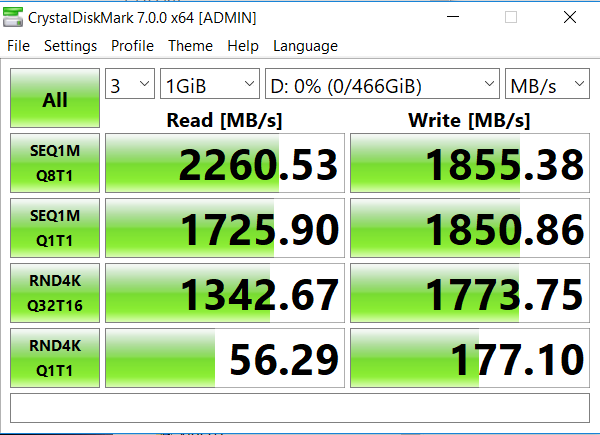CRYSTAL DISK BENCHMARK VER. 7.0.0 x64
Crystal Disk Benchmark is used to measure read and write performance through sampling of random data which is, for the most part, incompressible. Performance is virtually identical, regardless of data sample so we have included only that using random data samples.
THROUGHPUT
IOPS
Crystal DiskMark high sequential speeds of 2.2GB/s read and 1.8GB/s are what we might expect, and the random 4K IOPS high of 433K is encouraging, but we think the IOPS might be a just bit high as well.
The toughest benchmark available for solid state drives is AS SSD as it relies solely on incompressible data samples when testing performance. For the most part, AS SSD tests can be considered the ‘worst case scenario’ in obtaining data transfer speeds and many enthusiasts like AS SSD for their needs. Transfer speeds are displayed on the left with IOPS results on the right.The AS SSD results aren’t as appealing as we might like to see but do get a first look at read and write IOPS which appear to be in the general ball park of listed specs.
ANVIL STORAGE UTILITIES PROFESSIONAL
Anvil’s Storage Utilities (ASU) are the most complete test bed available for the solid state drive today. The benchmark displays test results for, not only throughput but also, IOPS and Disk Access Times. Not only does it have a preset SSD benchmark, but also, it has included such things as endurance testing and threaded I/O read, write and mixed tests, all of which are very simple to understand and use in our benchmark testing.
 The SSD Review The Worlds Dedicated SSD Education and Review Resource |
The SSD Review The Worlds Dedicated SSD Education and Review Resource | 


The flash is QLC, not TLC.
The ‘E’ in this number ‘MT29F1T08EMHAFJ4-3R:B’ which is drawn from the FBGA code NX959 designated TLC as listed in this part numbering decoder:
https://dtsheet.com/doc/1384381/nand-flash-part-numbering-system
A request for clarification has been sent off to Micron but I would like to hear your reasoning.
I think that you are right. I always thought that P2 was a P1 with a new generation of QLC NAND, just like Intel 660p -> 665p. The simple facts that it is not the SMI controller and there is no DRAM should make it a TLC drive. Sorry for the confusion.
The 500GB SKU is rated as 96L QLC but currently it’s using TLC.
Yes. That is why we believe that the performance is underrated with 960MB/s write…in anticipation of.
Nope… that’s ok. been known to slip every now and then as well. I think that’s how i retain readership…
I still don´t own a NVME-SSD and I don´t know if I´m the only one in the world which use the capacity of SSD.
But after tried some actual SSD-drives with 1TB and 2TB (less is senseless for me, have enoght of smaller SSDs) I´m annyoed about the “performance” of the SSDs. My ten years old HDDs beat some of these SSDs if I fill the capacity.
So a review without a squential write test of whole capacity is useless for me, sorry.
I apologize in advance but your comparison between the HDD and SSD is not physically possible. There is no way possible that a HDD can come anywhere near close to the start times and typical operations of a PC, simply because of the massive difference in seek time. The SSD is .01ms compared to any typical HDD a 9ms. We appreiate your comment in any case; this is an entry level SSD and the only really fair comparison might be to any HDD.
How would this drive compare to streaming a game from something like the mx500 SSD drive? I wonder about getting one of these just to be able to have some game streaming capacity in something like Star Citizen. These just seem very cheap to get into the NVMe game but maybe the low read speeds at smaller file sizes is a deal breaker?
I am not an expert on gaming but streaming, for the most part, relies on seek time which is much the same for most SSDs. The key to gaming and SSDs is scene transition as the scene is loaded into RAM which puts more of the concern on CPU and RAM. When I speak of SSDs such as the P2 and the ADATA Swordfish, both of which we just reported on, I would put them more in the hard drive to SSD transition category and leave them there…typical system operation. Stay tuned for my next review this week on the Kingston KC2500. This is a dynamite SSD and perhaps one of the best on the market for PCIe 3 right now.
Really like the improvements to the site.
Been with you since the XP941 days.
Ready for new Vermeer builds this year, your reviews will help again.
Great hearing from you James.